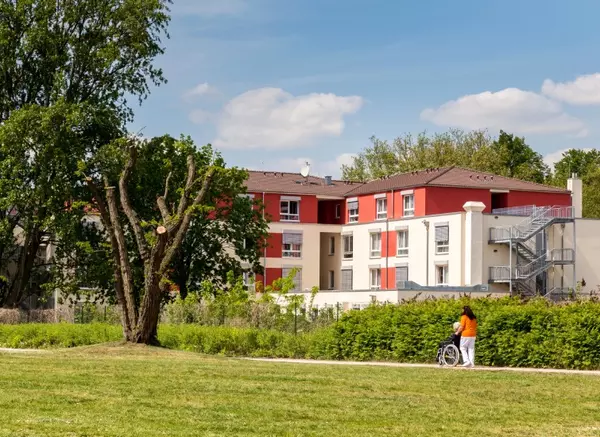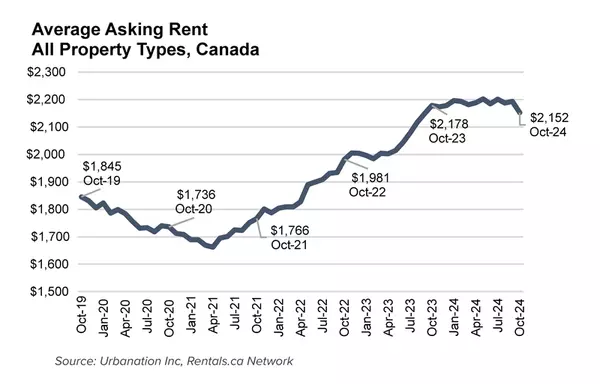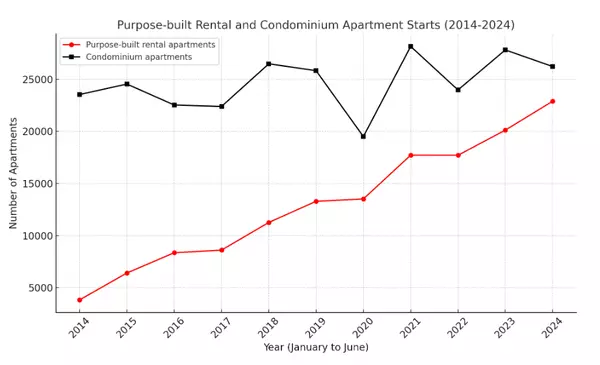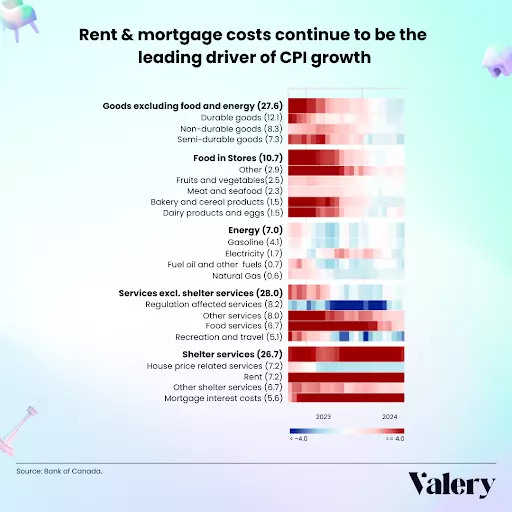
Collaborative solutions for Canada's housing crisis: Why non-profits are essential
The gravity of Canada’s housing crisis demands immediate collaborative action. To see solutions at work, Canada needs all levels of government and the development sector, including non-profits, to operate in lockstep with the same goal: to fuel the creation of multiple versions of housing, including rental and ownership, that build healthy, thriving communities. Working together for transformational action When government incentives are met by willing participants, transformational action takes place. For example, last fall, the federal government announced the removal of GST from purpose-built rental housing. This was a significant step in incentivizing the investment and development of more rental housing. Developers across the country reopened several projects in the development pipeline previously on hold, many making public commitments to adding new units to Canada’s housing stock. This type of incentive is certainly a step in the right direction. If we saw this was possible for purpose-built rentals, it’s important to develop a framework where this can be applied to the ownership market, making the pathway to homeownership an option for more Canadians. Non-profits can help us get there. How non-profits can help more Canadians own a home Home Ownership Alternatives (HOA), the company I lead, is a non-profit financial corporation making homeownership a reality for Canadians by working with both for-profit and non-profit developers. Our primary development partner is the non-profit developer Options for Homes. HOA offers a second mortgage program to help first-time homebuyers make a down payment on a unit within our developments. Last month, HOA and Options for Homes decided to join forces under the same leadership to deliver on our joint mission of increasing the supply of attainable housing suites on the market. While bringing these organizations together will help us to develop and deliver our pipeline, we still need support and significant contributions from private and public partners to continue to make non-profit housing development possible. Addressing challenges of non-profits in creating housing access Housing is important for all Canadians and homeownership is just one type of housing on that spectrum. But while more Canadians from all stages of life feel their pathway to enter the housing market is slipping, it’s important for non-profit organizations to exist and thrive to give more Canadians the pathway and option for ownership, something that should not only be reserved for a select few. While non-profits possess the missions, skills and expertise to ensure the right residents have access to the type of housing they need, they face significant challenges, including regulatory barriers and limited access to capital and land for development, which can hinder their ability to scale solutions. If we lower the costs for non-profits to invest in building new stock through government incentives and strategic partnerships, we lower the cost of delivering housing. It’s in this process that we can begin to scratch the surface of this crisis, addressing the housing deficit built up over decades to provide more housing options for Canadians. Health and vitality of our cities are at risk While the solution to the housing crisis continues to centre on building more and building faster, consideration must also be given to how and where we build. The health of our cities is an important conversation we must consider when we discuss solutions to the housing crisis. Importantly, when artists, educators, small business owners, hospitality workers, students and new Canadians cannot afford to live in our cities, we risk the health of delivering culture and services. When we are unable to house our workforce, there is a risk of employers choosing to leave our cities. The health and vitality of our cities are the real threats we face. Innovative housing models can help Innovative housing models, such as co-living communities and rent-to-own, offer promising solutions by increasing supply and enhancing the social and environmental sustainability of neighbourhoods. Encouraging such models through zoning reforms and incentives can spur non-profit development that aligns with the broader goals of community health and resilience. To see healthy, thriving and vital Canadian cities, we need to ensure we are building all levels of housing across the spectrum. To get there, we need non-profits at the table. Ultimately, Canada’s housing crisis stems from a supply and demand issue. To move forward, we must have all levels of government, private sector development and non-profit players working together to increase the supply of all types of housing on the spectrum to build healthy and thriving communities. Enjoying this article? Get the latest REM articles in your inbox 3x week so you stay up to date on the latest in the Canadian real estate industry

Hurdles faced by housing industry must be reduced
Famed theoretical physicist Albert Einstein once quipped, “You never fail until you stop trying.”Hopefully, policymakers and various levels of government will embrace the axiom and continue to brainstorm and work on fixes to the current housing supply and affordability crisis.High interest rates and material costs have made it difficult for developers and builders to construct homes that are affordable.Nationally, the annual pace of housing starts in January slowed by 10 per cent compared to December. The seasonally adjusted rate came in at 223,589 units, compared to 248,968 in December. We are falling short of housing targets while our population continues to increase.We must persevere, though. The way we deal with these challenges will determine our ultimate success.Several issues of our own making are adding to the problem. Exorbitant taxes, fees and levies are making new housing unaffordable, overly restrictive rules on density in our cities hinder our ability to add more housing supply, and excessive regulations and red tape delay approvals.Tax burden on new housing must be reducedWe know from a study done by the Canadian Centre for Economic Analysis that taxes, fees and levies on the purchase of a new home in Ontario accounts for a whopping 31 per cent of the price, up from 24 per cent in 2012. Most of these fees were added in less than a generation and equal a downpayment today. Housing is taxed as much as cigarettes and alcohol.Our taxes, fees and levies are the highest in North America, and combined with other factors, are eliminating first-time homebuyers from the housing market. We need to reverse or significantly reduce charges at the municipal level. The federal government also must step up and provide more equitable transfers to municipalities for infrastructure to support housing.More housing density must be allowedWe must also permit more as-of-right density in our major cities, especially along avenues and corridors.The City of Toronto has taken steps to adopt measures that will allow single-family homes to be converted into duplexes, triplexes and fourplexes in all low-rise residential areas, which is positive.The policy could transform up 70 per cent of Toronto’s yellowbelt area where only one single home per lot was permitted.The city must now bring in as-of-right zoning for mid-rise residential buildings along arterial roadways and avenues and allow for more housing density around mass transit areas. To build higher along arterials, a builder must obtain a zoning bylaw amendment which takes far too long.Regulatory hurdles must be minimizedAdditionally, we must immediately implement major changes in municipal planning and development divisions to specifically expedite housing applications and streamline approvals.The approvals process is simply too slow and there is a startling lack of accountability and transparency. Municipalities have been inconsistent in how they address the hurdles to development. Some cities have made progress towards speeding up approvals, but others are lagging.Canada is at the bottom of the barrel when it comes to roadblocks that prevent new housing construction. We are in 33rd place out of 35 OECD countries when it comes to timelines to undertake construction projects. Further, we are 64th out of 190 countries in construction permitting.Delays in approvals can add between eight and 14 per cent in additional construction-related costs annually, amounting to between $9 and $19 per square foot, according to a 2023 study.Development applications in Toronto are taking 908 days for site plan approval, or 713 days for a zoning bylaw decision. It took on average 32 months to get an approval in 2022, up from 21 months two years earlier.Recently, a study done by the Canadian Federation of Independent Business highlighted the costs associated with a $20,000 project to convert a powder room to a full bathroom renovation in major cities across the country and noted it would require 10 forms and permits to be submitted in Toronto. They include floor plans, an application to construct or demolish, and even a review by an architect or engineer which could add five to 20 per cent to the cost.If there are that many hurdles for a bathroom conversion, can you imagine trying to build something simple like a secondary suite?Some positive steps have been takenThere is some good news, though.In Toronto, the city has launched an online data hub aimed at improving transparency around its plan to build more housing. The new reporting system is a positive move as it will bring together key housing data and track the city’s progress toward meeting its housing target. Data in the hub will be presented via an online dashboard as well as an annually published data book.The federal and provincial governments have also eliminated sales taxes on new purpose-built rental buildings. This measure should be extended to first-time buyers of all types of residential buildings.The forces against the residential building industry are strong. But we must find a way to cut through the headwinds.Richard Lyall is president of the Residential Construction Council of Ontario (RESCON). He has represented the building industry in Ontario since 1991. Contact him at media@rescon.com.

Canada's Smart Home Revolution: Embracing the Future
Imagine your home not just as a shelter, but as an active participant in your quest for a sustainable lifestyle.In Canada, the evolution of smart homes is not just about the latest gadgets; it’s about a profound shift towards energy efficiency and a greener future. With the nation’s goal to hit net-zero emissions by 2050, your living space is set to play a pivotal role.As you seek comfort and convenience, the Canadian real estate market is responding with homes that are as smart as they are cozy. The integration of smart technology is redefining homes, turning them into hubs of efficiency and innovation, all while adding value to your investment. Let’s delve into how this transformation is unfolding across the country.The Beginnings of Smart Homes in CanadaThe First Smart Home TechnologiesThe advent of smart technology in homes dates back further than you might think. Before the buzzword ‘Internet of Things’ (IoT) became popular, early signs of smart technology were making their way into the market. In the late nineties, the first smart devices began to appear. These were crude by today’s standards but served as the vanguard for the smart revolution in home automation.By the early 2000s, groundbreaking products started hitting the shelves, becoming increasingly affordable to the average consumer. At that point, these devices focused mainly on automation, simplifying tasks that were traditionally manual and time-consuming. The release of the first WiFi-enabled thermostat by Nest in 2010 was a significant milestone, showcasing the convenience and efficiency that interconnected devices could offer. Now, nearly everything in a home, from toasters to beds, could be managed through apps on phones, creating an ecosystem of smart living.Adoption of Smart Home Features by CanadiansYour engagement with smart technology likely began with something as simple as a smart speaker or as intricate as a home security system. These innovations are not just about the allure of convenience; they also play a crucial role in energy efficiency and safety. Smart home statistics paint a vivid picture of Canadian households adopting these technologies. In 2019, 27% of Canadians owned at least one smart home device. Fast forward to 2021, and only 24% did not possess any smart technology, illustrating rapid growth in just two years.The trend doesn’t stop there – 78% of Canadians surveyed indicated their interest in expanding their collection of smart devices within the year. These preferences underscore the increasing integration of smart home solutions into the Canadian lifestyle. The data is clear: there’s a strong affinity towards smart homes in Canada, driven by their ability to enhance everyday life through ease of use, energy savings, and improved home security.Advancements in Smart HomesIntegration of Artificial IntelligenceArtificial Intelligence (AI) has become a cornerstone in the evolution of smart homes. You’re likely familiar with voice-activated virtual assistants like Amazon’s Alexa or Google Assistant, which now feature prominently in households. These AI-driven systems command an array of IoT devices, literally putting smart home control on the tip of your tongue. From altering thermostats to queuing up your favorite playlist, these handy assistants are redefining the concept of living smart.IoT Devices and Increased ConnectivityThe interplay between IoT devices has transformed homes into interconnected hubs, where control and automation are just a tap away. With smartphone apps and voice commands, you now wield the power to orchestrate your living space, from tweaking lighting moods to locking doors, all remotely. It’s a demonstration of how increased connectivity is meeting your thirst for convenience and efficiency.Energy Efficiency and SustainabilityAmong the most applauded advancements in smart homes is their potential to shape a sustainable future. Energy efficiency doesn’t just feature in discussions; it’s an actionable reality. Smart technologies allow you to optimize energy usage, diminishing the carbon footprint one device at a time. Given the urgency of environmental sustainability, these solutions are not just nice to have—they’re a long-term must.Smart thermostats and lighting systems lead the charge, providing you with real-time feedback and automated adjustments that make energy-saving second nature. Not only do you cut down on power bills, but you also participate in a larger movement towards conserving the planet’s resources. This fusion of technology and eco-consciousness marks a pivotal step in home automation, aligning with global efforts to promote energy stewardship.Challenges and ConcernsPrivacy and Security RisksAs your home becomes increasingly intelligent, the data it processes does too. Smart devices collect a wealth of information, fostering concerns about who else could be listening in or taking control. In Canada, tales of hacked baby monitors and compromised security cameras serve as harrowing reminders of potential privacy violations.Affordability and AccessibilityYou might be enticed by the promise of a smart home until you glance at the price tag. Sophisticated systems often come with a premium cost, putting them out of reach for the average Canadian. Adding more advanced smart home features inevitably inflates the overall expense, making affordability a significant hurdle.Technological Complexity and Skill RequirementsAs homes evolve into hubs of interconnected devices, the complexity can be overwhelming. For some, the technological literacy needed to operate and maintain an ecosystem of diverse gadgets can be daunting. You must understand how to configure networks, troubleshoot issues, and stay ahead of the latest software updates – a tall order for those not tech-savvy.The Future of Smart Homes in CanadaSmart Homes for Aging in PlaceWith demographic shifts leading to an aging population, Canadian homes must adapt to meet the needs of seniors who choose to live independently. Smart home technologies support aging in place by enhancing home safety and improving the quality of life for older adults. Innovations showcased at global tech events have made waves in the sector, from sensor technologies detecting changes in daily routines to advanced lighting systems that prevent falls.Smart Grid Integration for Energy ManagementSmart grid technology is set to transform how energy is distributed and managed in Canadian households. Real-time insights into energy consumption, gained through advanced metering, empower you to monitor and reduce your energy usage. This not only leads to cost savings but also helps Canada progress towards its net-zero emissions goal by 2050.ConclusionSmart homes in Canada are evolving rapidly, driven by AI and IoT advancements. While they promise enhanced safety, energy efficiency, and health management, they’re not without their challenges.Addressing security, affordability, and technical complexities is crucial for their wider adoption. It’s clear that the future of smart homes hinges on building user trust and ensuring data protection. As technology progresses, you may soon find yourself living in a home that’s not only intelligent but also an integral part of a connected, sustainable society.
Categories
Recent Posts











